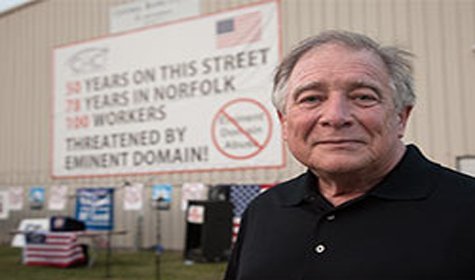Arlington, Va.—Ten years ago, in its infamous Kelo decision, the U.S. Supreme Court adopted a radically broad interpretation of the government’s power to take private property through eminent domain. But the Court recognized that the “necessity and wisdom of using eminent domain” are “matters of legitimate public debate.” Central Radio Company attempted to participate in that debate when the government tried to take its property through eminent domain. The city of Norfolk, Va., however, prevented it from doing so, barring the company from hanging a protest banner on the land in dispute. Now Central Radio is taking its fight to the U.S. Supreme Court, asking the Court to review a major case at the intersection of free speech and property rights.
“This case demonstrates just how intertwined our constitutional rights are—how protecting free speech is essential to protecting our other fundamental liberties, including property rights,” noted Michael Bindas, a senior attorney with the Institute for Justice, which represents Central Radio.
Central Radio has been a Norfolk institution for more than 80 years, but in 2010 the Norfolk Redevelopment and Housing Authority moved to take its land and building through eminent domain and turn it over to nearby Old Dominion University (a land grab Central Radio would ultimately defeat). In response to the threat, Central Radio hung a 375-square foot protest banner on the very building the government was trying to take. It read: “50 years on this street/78 years in Norfolk/100 workers/Threatened by eminent domain!”
Acting on a complaint made by an official at Old Dominion—the very entity that stood to acquire Central Radio’s property—the city quickly cited Central Radio and ordered the banner be taken down. Yet, under Norfolk’s sign code, the banner would have been allowed if it had fallen into one of the various favored categories of signs that Norfolk exempts from regulation. For example, a banner of the same size, in the same location, would have been perfectly permissible if, rather than protesting city policy, it depicted the city flag or crest.
In the fall of 2013, the Virginia Supreme Court held that the city’s attempted taking of Central Radio’s property was illegal, vindicating the company’s property rights. Unfortunately, however, the federal courts refused to vindicate Central Radio’s free speech rights. When the company challenged the city’s sign code under the First Amendment, the U.S. District Court for the Eastern District of Virginia upheld it. And in January 2015, a divided 2-1 decision of the U.S. 4th Circuit Court of Appeals affirmed the district court.
According to the 4th Circuit majority opinion, it was irrelevant that the sign code drew distinctions between different types of banners based on their content so long as those distinctions were what the court deemed “reasonable.” Moreover, restricting Central Radio’s banner was warranted, according to the majority, because some passersby had “reacted emphatically” to the sign by waving, honking and shouting in support when they saw it. The majority claimed that these expressions of support were evidence that “motorists [we]re distracted by [the] sign while driving.”
“Unfortunately, the 4th Circuit allowed Norfolk to play favorites with the First Amendment by arbitrarily deciding who gets to speak and what they get to say,” explained Bindas. “Worse, it held that Norfolk was justified in restricting Central Radio’s banner precisely because it was effective. The honking, waving and shouting of passing motorists were expressions of support for Central Radio—not evidence of distraction. Government cannot regulate speech based on the supportive reactions of those who see or hear it.”
Judge Roger Gregory issued a powerful dissent from the majority’s opinion. “This case implicates some of the most important values at the heart of our democracy: political speech challenging the government’s seizure of private property—exactly the kind of taking that our Fifth Amendment protects against,” wrote Judge Gregory. “If a citizen cannot speak out against the king taking her land, I fear we abandon a core protection of our Constitution’s First Amendment.”
Yesterday, March 31, 2015, Central Radio filed a petition for certiorari asking the U.S. Supreme Court to review and overturn the 4th Circuit’s decision. It argues that the distinctions drawn by Norfolk’s sign code are impermissibly content-based, and that government cannot suppress speech based on the fact that passersby express their support for its message. The first of those issues may be resolved in Reed v. Town of Gilbert, which is pending before the Court and also involves the question of whether a municipal sign code may constitutionally treat some types of speech better than others.
“We will not rest until the free speech rights of all Americans are firmly secured,” said Chip Mellor, president and general counsel of the Institute for Justice. “Courts must respect and protect the right of citizens to stand up against an abusive government and speak out in defense of their rights.”
Key Facts
- This case started with government abusing its power of eminent domain.
- 10 years ago, the U.S. Supreme Court issued its infamous Kelo ruling eviscerating constitutional protections against eminent domain abuse.
- Company hung a protest banner; the government demanded they cover it up.
For a copy of the Institute for Justice’s cert petition, visit: http://ij.org/images/pdf_folder/first_amendment/norfolk_va-speech/norfolk-cert-petition-4-1-15.pdf.
Founded in 1991, the Institute for Justice is the national law firm for liberty. To learn more about this case, visit www.ij.org/central-radio-company-v-city-of-norfolk.

